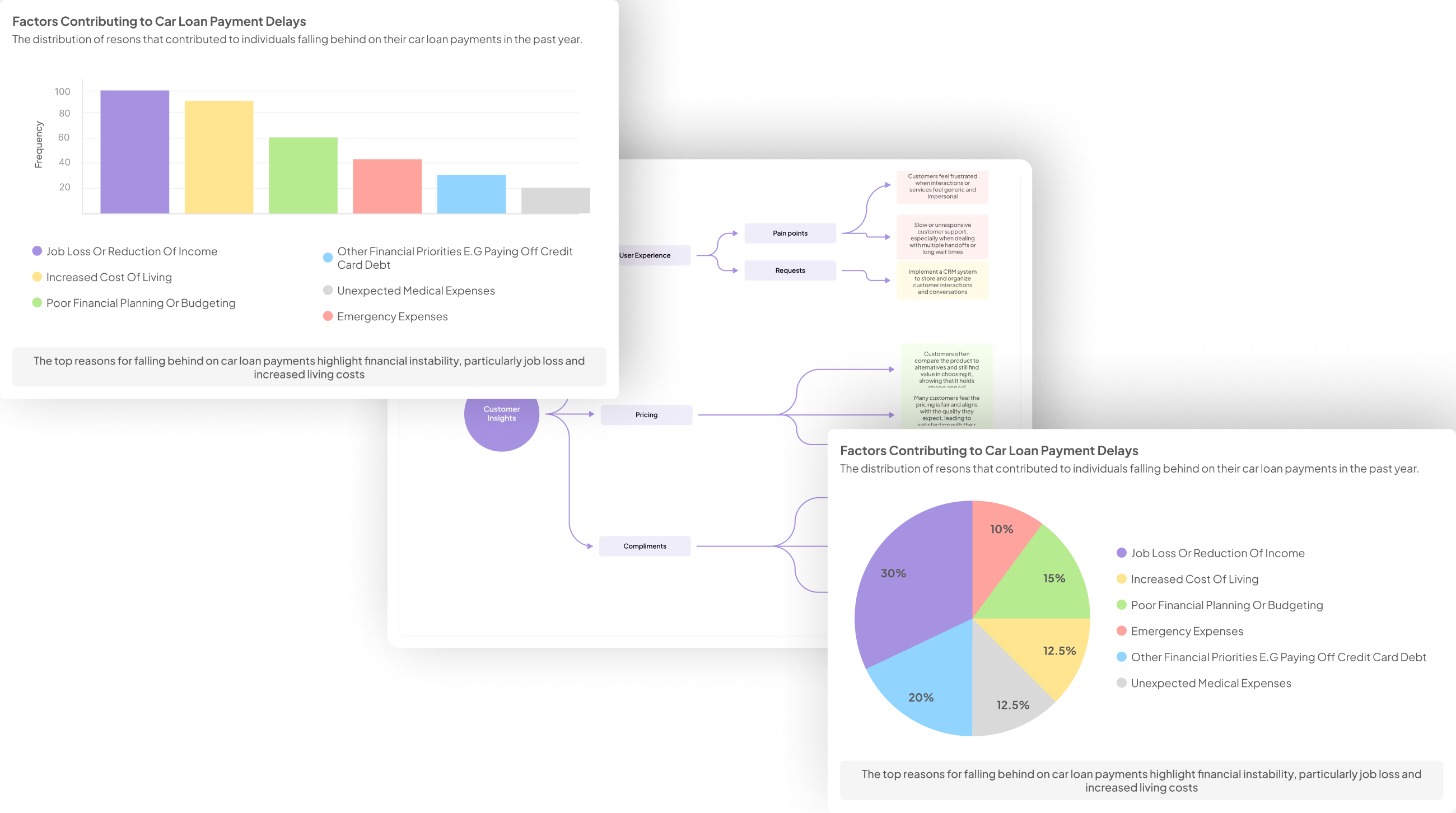Market Research and Analytics: Complete Breakdown
-
Hello Insight
- 10 min read
Consumer Insight Analysis serves as a powerful tool in market research, guiding businesses towards better decision-making. Understanding consumer behavior and preferences allows organizations to tailor their products and services, ensuring they meet customer needs.
To effectively conduct Consumer Insight Analysis, consider the following key steps. First, gather qualitative and quantitative data through surveys and interviews, yielding rich insights into consumer attitudes. Next, segment your audience based on demographics and behavioral patterns, allowing for targeted marketing strategies. Third, employ predictive analytics to forecast future consumer behaviors and trends, enabling proactive business adjustments. Lastly, regularly review and adapt your strategies based on ongoing consumer feedback to maintain relevance and competitiveness in the market. By embracing these components, businesses can build meaningful connections with their customers, ultimately driving success in today’s dynamic market landscape.
Introduction to Market Research and Consumer Insight Analysis
Market research is a powerful tool that transforms raw data into meaningful insights about consumer behavior. Introduction to Consumer Insight Analysis begins here, focusing on understanding your audience deeply and tailoring strategies to meet their needs. This process is crucial for businesses aiming to stay competitive and relevant in an ever-evolving marketplace.
In this section, we will explore various methods of gathering and analyzing consumer insights. By identifying trends and understanding customer motivations, businesses can make informed decisions that drive growth. The objective is not just to collect data but to turn it into actionable insights that can shape future strategies effectively.
Generate visualizations from your qualitative data. At Scale.

Exploring the Fundamentals of Market Research
Market research is the cornerstone of understanding consumer behavior and preferences. By delving into the fundamentals, businesses can uncover valuable insights that inform their strategies. One vital aspect of this process is Consumer Insight Analysis, which focuses on interpreting data to understand the needs and desires of customers. This analysis illuminates patterns in consumer behavior, allowing companies to tailor their products and services effectively.
To explore this further, it’s essential to grasp key components such as data collection methods, segmentation, and the importance of qualitative data. Various methodologies serve to enhance this analysis, including surveys, focus groups, and observational research. By integrating these techniques, companies can paint a comprehensive picture of their target audience. Ultimately, mastering these fundamentals equips businesses with the tools needed to respond adeptly to market trends and consumer sentiments, fostering long-term loyalty and growth.
Understanding Consumer Insight Analysis in Market Research
Consumer Insight Analysis plays a crucial role in enhancing market research efforts. This process involves gathering data related to consumer behaviors, needs, and preferences, enabling businesses to understand their target audience better. By interpreting these insights, organizations can make informed decisions regarding product development, marketing strategies, and customer engagement practices.
Effective Consumer Insight Analysis typically includes several steps. Firstly, it begins with data collection through various methods like surveys, focus groups, and social media listening. Next, data analysis is performed to extract meaningful patterns and trends. Finally, these insights are translated into actionable strategies that can drive business growth. Companies that invest in understanding consumer insights stand to improve their brand perception and customer satisfaction significantly. Thus, integrating insightful analysis into market research can lead to more tailored and effective marketing approaches.
Key Components and Methodologies
Effective consumer insight analysis involves several key components and methodologies that drive market research. Understanding what customers think and feel is crucial for businesses aiming to tailor their strategies. The first vital element is understanding your target audience. This means gathering demographic data, preferences, and behaviors to inform your approach. Additionally, qualitative methods such as interviews or focus groups provide deeper insights into consumer motivations and challenges.
Another essential component is data analysis. Employing both qualitative and quantitative methodologies can yield valuable insights. Quantitative analysis allows for statistical evaluation of consumer behaviors, while qualitative analysis focuses on interpreting complex patterns and trends. Techniques like surveys and feedback loops enable businesses to adapt quickly to changing market demands. To enhance the efficacy of these methodologies, organizations can utilize modern tools to automate data collection and analysis processes. Ultimately, integrating these components fosters a robust understanding of consumer insights, paving the way for informed decision-making.
Understanding Consumer Insight Analysis in Market Research focuses on examining how businesses can harness consumer data to make informed decisions. Consumer insights are derived from various data sources, including surveys, interviews, and social media interactions. By analyzing this data effectively, companies can identify emerging trends and preferences, enhance their products, and tailor their marketing strategies accordingly.
Consumer Insight Analysis involves several key steps. First, businesses must collect relevant data to reflect customer behaviors and preferences. Next, they should interpret this data to uncover actionable insights. Finally, these insights should be integrated into strategic planning, ensuring that business decisions align with consumer expectations. By mastering consumer insight analysis, organizations can foster deeper connections with their audiences and stay ahead in competitive markets.
Evaluate Performance on Customer Calls for Quality Assurance.
Advanced Consumer Insight Analysis Techniques
Advanced Consumer Insight Analysis Techniques are essential for understanding market dynamics and consumer behaviors. To effectively harness these strategies, businesses need to delve into advanced methodologies that uncover valuable insights. By utilizing techniques such as predictive analytics and psychographic segmentation, organizations can gain a more profound understanding of their customer base and tailor their offerings accordingly.
One key approach is segmenting consumer insights for targeted marketing efforts. This involves analyzing demographics, behaviors, and preferences to identify distinct customer groups. Utilizing predictive analytics enhances this process by forecasting consumer trends and responses, aiding businesses in making informed decisions. Importantly, integrating these techniques helps in transforming raw data into actionable strategies, ensuring that companies remain competitive in an ever-evolving market landscape. By adopting these advanced techniques, organizations can foster a data-driven culture and effectively respond to consumer needs.
Segmenting Consumer Insights for Better Targeting
Segmenting consumer insights involves breaking down gathered data into distinct groups to enhance targeting effectiveness. This strategy ensures that businesses tailor their marketing efforts to meet the specific needs of different consumer segments. By implementing consumer insight analysis, organizations can uncover valuable patterns and preferences that drive purchasing decisions.
To segment insights effectively, it’s essential to consider four key factors: demographics, psychographics, behavioral traits, and geographic location. Demographics offer information based on age, gender, and income, while psychographics delve into consumer attitudes and lifestyles. Behavioral traits focus on purchasing habits and brand interactions, and geographic location allows for region-specific targeting. Understanding these variables empowers businesses to create more personalized marketing strategies, ultimately fostering stronger customer relationships and increasing conversion rates. By prioritizing the segmentation of consumer insights, brands can craft targeted campaigns that resonate more deeply with their audience, driving engagement and loyalty.
Predictive Analytics in Consumer Insight Analysis
Predictive analytics plays a pivotal role in consumer insight analysis, allowing businesses to anticipate future behaviors based on historical data. By utilizing advanced statistical techniques and machine learning algorithms, companies can identify patterns that help determine how consumers might respond to changes in products or marketing strategies. This proactive approach enables firms to not only meet consumer needs but also stay ahead of market trends.
The process typically involves collecting and analyzing vast amounts of consumer data, which can uncover valuable insights. Three key areas of focus include understanding customer preferences, predicting purchasing behavior, and assessing potential market risks. With this information, businesses can craft targeted campaigns, develop products that resonate with consumers, and ultimately enhance their competitive edge. As market dynamics continue to evolve, embracing predictive analytics in consumer insight analysis becomes essential for sustainable growth.
Conclusion: Harnessing Market Research for Effective Consumer Insight Analysis
Effective consumer insight analysis is vital for unlocking valuable information from market research. By understanding consumer behavior, preferences, and trends, businesses can make informed decisions that enhance their offerings. Market research provides a framework for collecting data, which, when analyzed correctly, reveals patterns that guide strategic initiatives.
In conclusion, harnessing these insights leads to a deeper understanding of the target audience. Organizations can tailor marketing strategies to meet consumer needs, ultimately driving growth and customer satisfaction. Investing time and resources in market research ensures that companies remain competitive and aligned with evolving market demands.
Consumer Insight Analysis delves into understanding customer behavior, preferences, and needs. This analysis is critical as it informs strategies aimed at enhancing customer experiences and product offerings. By effectively harnessing insights from various research methodologies, businesses can gain a deeper understanding of their target market.
To conduct an effective Consumer Insight Analysis, one could consider several key components:
1. **Data Collection**: Utilize surveys, interviews, and focus groups to gather qualitative and quantitative data.
2. **Data Segmentation**: Segment the collected data to identify distinct consumer groups based on demographics, preferences, or purchasing behavior.
3. **Insight Generation**: Analyze the data to uncover trends, patterns, and areas for improvement.
These components work together to provide a comprehensive view of consumer behavior and preferences. Insights gained from this analysis can guide product developments and marketing strategies, ensuring they align with consumer demands.






